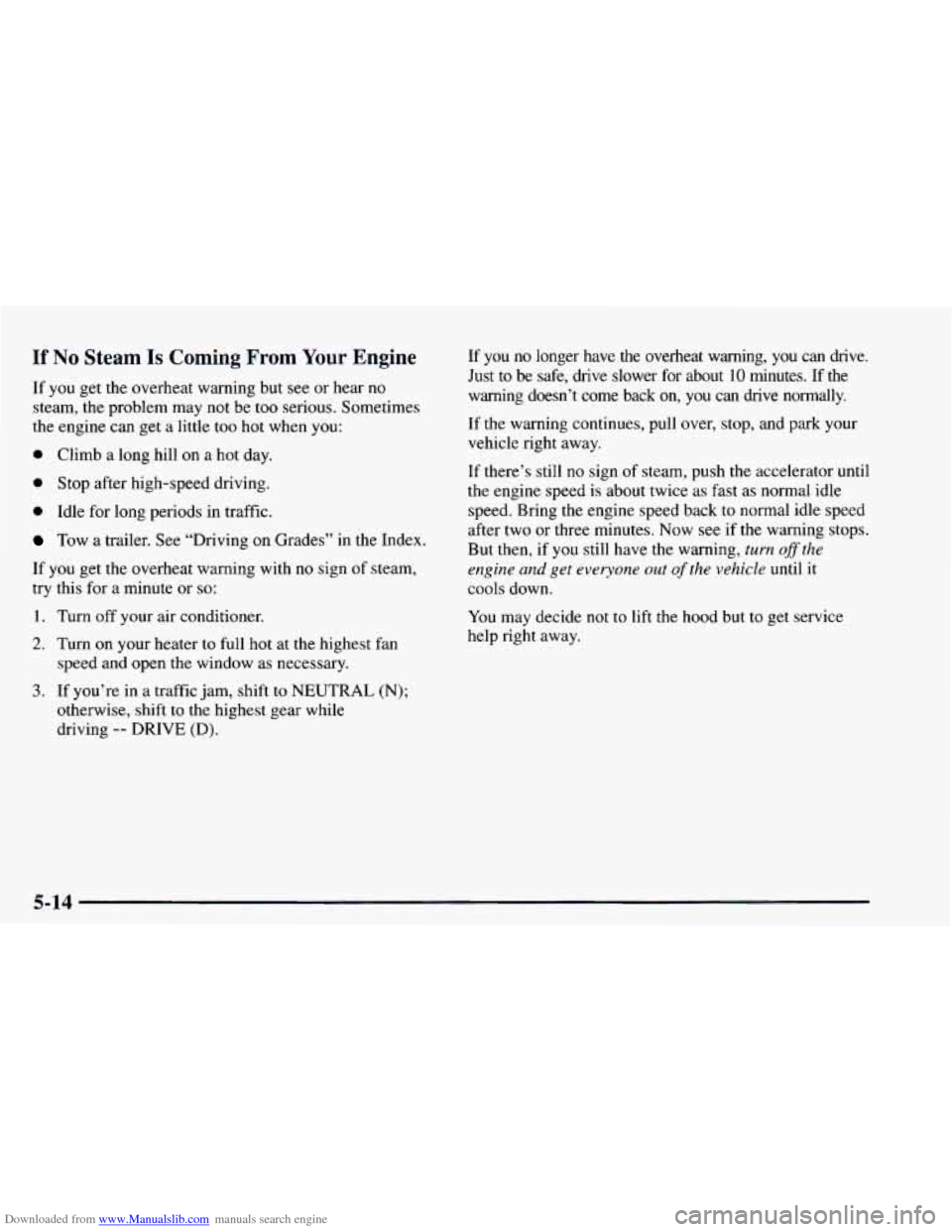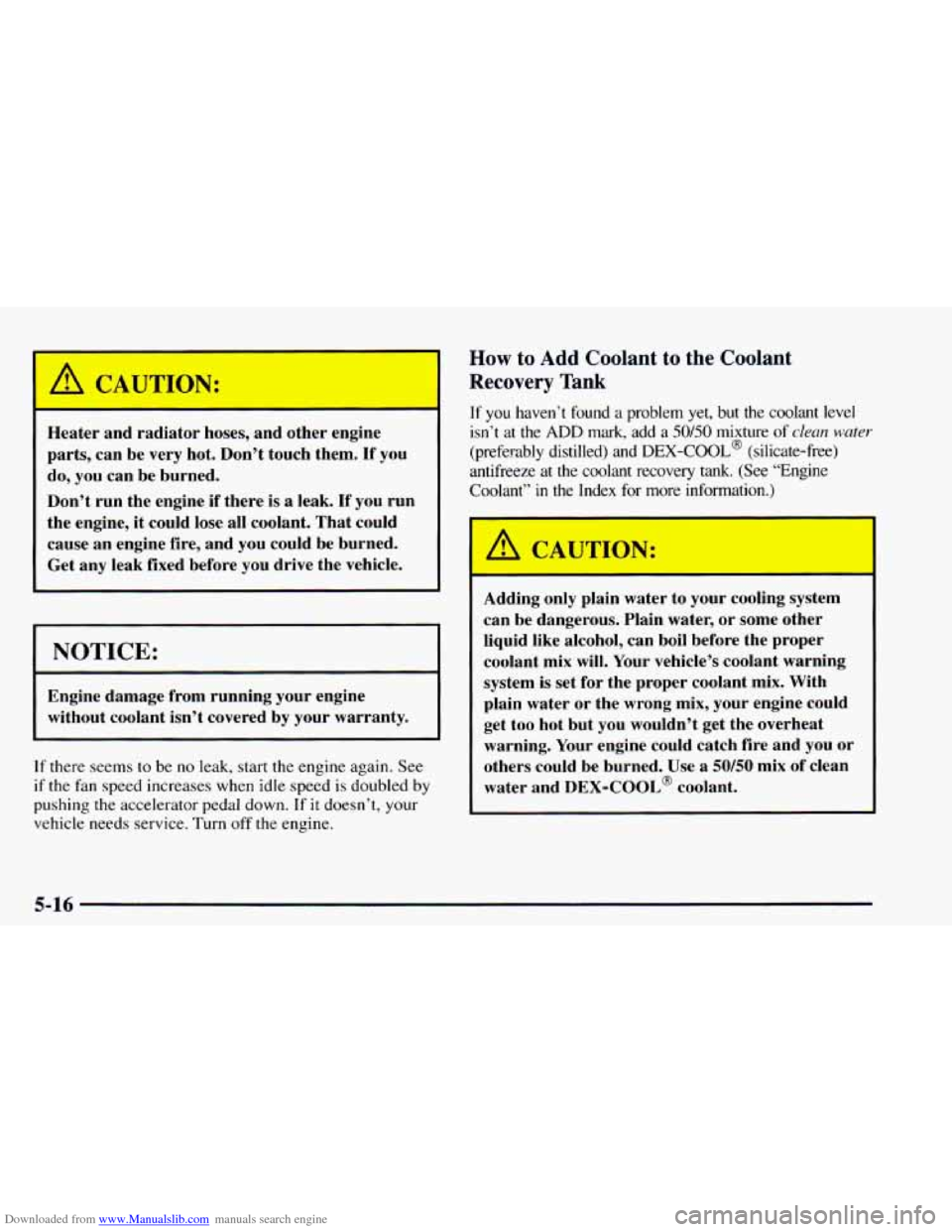Page 153 of 404

Downloaded from www.Manualslib.com manuals search engine Your vehicle has air vents near the center and on the
sides
of the instrument panel that allow you to adjust the
direction and
the amount of airflow inside the vehicle.
Push the vent up or down to direct airflow
to your
preference. Increase or reduce the amount of airflow by
opening and closing the louvers. The vents rotate to
direct
the airflow from side to side. When
you close a vent,
it will increase the flow of air
coming out
of any vents that are open.
If you have rear heating or rear air conditioning, you
will have adjustable vents in the rear of the vehicle to
help direct the airflow. The rear air conditioning vents
are located
in the headliner at the rear of the vehicle.
The rear heating vents are located
next to the second and
third seat
on the driver’s side of the vehicle, near the
floor. You can move the vents to direct the flow
of air, or
close
the vents altogether. When you close a vent, it will
increase the flow of air coming out of any vents that
are open.
Ventilation Tips
0
0
0
Keep the hood and front air inlet free of ice, snow or
any other obstruction (such
as leaves). The heater
and defroster
will work far better, reducing the
chance of fogging the inside
of your windows.
When you enter a vehicle
in cold weather, turn the
blower fan to
HIGH for a few moments before
driving off. This helps clear the intake ducts
of snow
and moisture, and reduces the chance of fogging the
inside of your windows.
Keep the air path under
the front seats clear of
objects. This helps air to circulate throughout
your vehicle.
3-7
Page 154 of 404
Downloaded from www.Manualslib.com manuals search engine Rear Window Defogger
If your vehicle has this option,
(Option)
the rear window will
The rear window defogger will only work when the
ignition switch is
in the RUN position,
have lines running across the glass. These lines heat
your window.
For best results, clear the window
of as much snow or
ice as possible before using the rear window defogger.
To turn on the rear window
defogger, find the button to
the left of the heater
Press the button until the light comes
on, then release it.
You can turn the defogger off at any time by pressing
the button again. The defogger will shut itself
off after
several minutes
so that the glass does not get too hot. If
the
window still isn’t clear$ turn the defogger on again.
NOTICE:
Scraping the inside of your rear window could
cut and damage the defogger.
Your warranty
would
not cover this damage. And don’t put
decaIs there, you might have to scrape them off.
3-8
Page 203 of 404

Downloaded from www.Manualslib.com manuals search engine This can cause deadly CO (carbon monoxide) gas
to get inside.
CO could overcome you and kill
you.
You can't see it or smell it, so you might not
know
it is in your vehicle. Clear away snow from
around the base
of your vehicle, especially any
that
is blocking your exhaust pipe. And check
around again from time
to time to be sure snow
doesn't collect there.
Open
a window just a little on the side.of the
vehicle that's
away from the wind. This will help
keep
CO out.
Run your engine only as long as you must. This saves
fuel. When you run the engine, make it go a little faster
than just idle. That is, push the accelerator slightly. This
uses less fuel for the heat that you get and it keeps the
battery charged. You will need a well-charged battery to
restart the vehicle,
and possibly for signaling later on
with your headlamps. Let the heater run for awhile.
Then, shut the engine
off and close the window almost
all the way to preserve the heat. Start the engine again
and repeat this only
when you feel really uncomfortable
from the cold. But do it as little as possible. Preserve the
fuel as long as you can.
To help keep warm, you can get
out
of the vehicle and do some fairly vigorous exercises
every half hour or
so until help comes.
4-27
Page 232 of 404

Downloaded from www.Manualslib.com manuals search engine If No Steam Is Coming From Your Engine
If you get the overheat warning but see or hear no
steam, the problem may not be too serious. Sometimes
the engine
can get a little too hot when you:
0 Climb a long hill on a hot day.
0 Stop after high-speed driving.
0 Idle for long periods in traffic.
Tow a trailer, See “Driving on Grades” in the Index.
If you get the overheat warning with no sign of steam,
try this for
a minute or so:
1. Turn off your air conditioner.
2. Turn on your heater to full hot at the highest fan
speed and open the window as necessary.
3. If you’re in a traffic jam, shift to NEUTRAL (N);
otherwise, shift to the highest gear while
driving
-- DRIVE (D). If you no longer have the overheat warning, you can drive.
Just to
be safe, drive slower for about 10 minutes. If the
warning doesn’t come back
on, you can drive normally.
If the warning continues, pull over, stop, and park your
vehicle right away.
If there’s still no sign of steam, push the accelerator until
the engine speed is about twice as fast as normal idle
speed. Bring the engine speed back to normal idle speed
after two or three minutes. Now see if the warning stops.
But then, if you still have the warning,
turn ofthe
engine
and get everyone out of the vehicle until it
cools down.
You may decide not to lift the hood but to get service
help right away.
5-14
Page 233 of 404
Downloaded from www.Manualslib.com manuals search engine Cooling System
When you decide it’s safe to lift the hood, here’s what
you’ll see:
A. Coolant Recovery Tank
B. Radiator Pressure Cap
C. Engine Fan
If the coolant inside the coolant recovery tank is boiling,
don’t do anything else
until it cools down.
The coolant level should be at the ADD mark.
If it isn’t, you may have a leak in the radiator hoses,
heater hoses, radiator, water pump or somewhere
else in
the cooling system.
5-15
Page 234 of 404

Downloaded from www.Manualslib.com manuals search engine A CAUTION:
-----
Heater and radiator hoses, and other engine
parts, can be very hot. Don’t touch them.
If you
do, you can be burned.
Don’t run the engine if there is
a leak. If you run
the engine, it could lose all coolant. That could
cause an engine fire, and you could be burned.
Get any leak fixed before you drive the vehicle.
I NOTICE:
Engine damage from running your engine
without coolant isn’t covered by your warranty.
If there seems to be no leak, start the engine again. See
if the fan speed increases when idle speed is doubled by
pushing the accelerator pedal down.
If it doesn’t, your
vehicle needs service. Turn off the engine.
How to Add Coolant to the Coolant
Recovery Tank
If you haven’t found a problem yet, but the coolant level
isn’t at the
ADD mark, add a 50/50 mixture of clean water
(prefembly distilled) and DEX-COOL@ (silicate-free)
antifreeze at the coolant recovery tank. (See “Engine
Coolant”
in the Index for more information.)
,/!
CAU [ON:
---
Adding only plain water to your cooling system
can be dangerous. Plain water, or some other
liquid like alcohol, can boil before the proper
coolant mix will. Your vehicle’s coolant warning
system
is set for the proper coolant mix. With
plain water or the wrong mix, your engine could
get too hot but you wouldn’t get the overheat warning. Your engine could catch fire and you or
others could be burned. Use
a 50/50 mix of clean
water and DEX-COOL@ coolant.
5-16
Page 235 of 404
Downloaded from www.Manualslib.com manuals search engine NOTICE:
In cold weather, water can freeze and crack the
engine, radiator, heater core and other parts. Use the recommended coolant and the proper
coolant mix. You
can be burned if you spill coolant on hot
engine parts. Coolant contains ethylene glycol
and it
will burn if the engine parts are hot
enough. Don’t spill coolant on a hot engine.
When the coolant
in the coolant recovery tank is at the
ADD mark, start your vehicle.
If the overheat warning continues, there’s one more
thing
you can try. You can add the proper coolant mix
directly
to the radiator, but be sure the cooling system is
cool before
you do it.
5-17
Page 273 of 404
Downloaded from www.Manualslib.com manuals search engine 6. Grasp the top of the heater duct and pull down gently
to remove
it.
7. Remove the two bolts at the engine cover. The bolts
are
not supposed to come out of the cover, only from
the front of the dash.
When removing the cover, be careful
not to damage
the instrument panel or the trim.
6-17